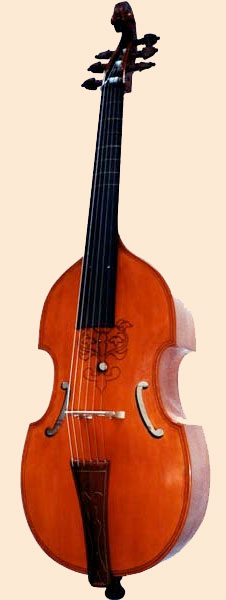
 |
What is a Viola da Gamba The viola da gamba, otherwise known as the viol, is any one of a family of bowed, fretted, and stringed musical instruments developed in the mid to late 15th century and used primarily in the Renaissance and Baroque periods. Music historians have traditionally related the viol family as descended primarily from the Renaissance vihuela, a plucked instrument that preceded the guitar. Viols are different in several respects from instruments of the violin family, most obviously in the presence of movable frets, in the six strings instead of the four of the violin family, in the instruments' flat rather than shaped backs, and in the fact that they are held between the knees rather than on the shoulder. There are 7 sizes in the viola da gamba family that increase in size from the small pardessus through the treble, the alto, the tenor, the 6-string bass, the larger 7-string bass, and the very large violone. With the exception of the violone, which rests on the floor, all the other sizes of the viola da gamba are held between the knees, hence the word "gamba," which means leg in Italian. Viols were second in popularity only to the lute (although this is disputed), and like lutes, were very often played by amateurs. Affluent homes might have a so-called chest of viols, which would contain one or more instruments of each size. Gamba ensembles, called consorts, were common in the 16th and 17th centuries, when they performed vocal music (consort songs or verse anthems) as well as that written specifically for instruments. Only the treble, tenor, and bass sizes were regular members of the viol consort, which consisted of three, four, five, or six instruments. Music for consorts was very popular in England in Elizabethan times, with composers such as William Byrd and John Dowland, and, during the reign of King Charles I, John Jenkins and William Lawes. The last music for viol consorts before their modern revival was probably written in the early 1680s by Henry Purcell. Perhaps even more common than the pure consort of viols was the mixed or broken consort (also called Morley consort). Today, the viol is attracting ever more interest, particularly among amateur players. This may be due to the increased availability of reasonably priced instruments from companies using more automated production techniques, coupled with the greater accessibility of music editions. The viol is also regarded as a suitable instrument for adult learners; Percy Scholes wrote that the viol repertoire "...belongs to an age that demanded musicianship more often than virtuosity." There are now many societies for people with an interest in the viol. The first was Viola da Gamba Society of Great Britain, which was established in the United Kingdom in 1948 and has a worldwide membership. Since then, similar societies have been organized in several other countries, including the United States' Viola da Gamba Society of America. The 1991 feature film Tous les matins du monde (All the Mornings of the World) by Alain Corneau, based on the lives of Monsieur de Sainte-Colombe and Marin Marais, prominently featured these composers' music for the viola da gamba and brought viol music to new audiences. The film's bestselling soundtrack features performances by Jordi Savall, one of the best-known modern viola da gamba players. Taken from, http://en.wikipedia.org/wikipedia |